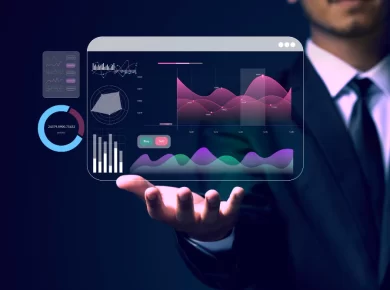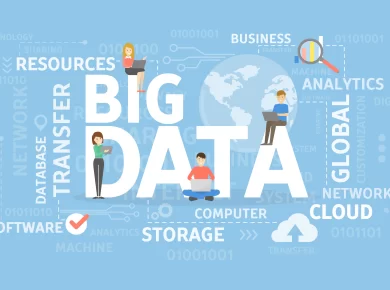In our daily lives, moving information from one location to another is no more than a simple copy-and-paste operation. Everything gets far more complicated when it comes to transferring millions of data units into a new system.
However, many companies treat even a massive data migration as a low-level, two-clicks task. Such an initial underestimation translates to spending extra time and money. Recent studies revealed that 55 percent of data migration projects went over budget and 62 percent appeared to be harder than expected or actually failed.
How to avoid falling into the same trap? The answer lies in understanding the essentials of the data migration process, from its triggers to final phases.
If you are already familiar with theoretical aspects of the problem, you may jump to the section Data Migration Process where we give practical recommendations. Otherwise, let’s start from the most basic question: What is data migration?
What is data migration?
In general terms, data migration is the transfer of the existing historical data to new storage, system, or file format. This process is not as simple as it may sound. It involves a lot of preparation and post-migration activities including planning, creating backups, quality testing, and validation of results. The migration ends only when the old system, database, or environment is shut down.

Usually, data migration comes as a part of a larger project such as
- legacy software modernization or replacement
- the expansion of system and storage capacities,
- the introduction of an additional system working alongside the existing application
- the shift to a centralized database to eliminate data silos and achieve interoperability
- moving IT infrastructure to the cloud, or
- merger and acquisition (M&A) activities when IT landscapes must be consolidated into a single system.
Data migration is sometimes confused with other processes involving massive data movements. Before we go any further, it’s important to clear up the differences between data migration, data integration, and data replication.
Data migration vs data integration
Unlike migration dealing with the company’s internal information, integration is about combining data from multiple sources outside and inside the company into a single view. It is an essential element of the data management strategy that enables connectivity between systems and gives access to the content across a wide array of subjects. Consolidated datasets are a prerequisite for accurate analysis, extracting business insights, and reporting.
Data migration is a one-way journey that ends once all the information is transported to a target location. Integration, by contrast, can be a continuous process, that involves streaming real-time data and sharing information across systems.
Data migration vs data replication
In data migration, after the data is completely transferred to a new location, you eventually abandon the old system or database. In replication, you periodically transport data to a target location, without deleting or discarding its source. So, it has a starting point, but no defined completion time.
Data replication can be a part of the data integration process. Also, it may turn into data migration — provided that the source storage is decommissioned.
Now, we’ll discuss only data migration — a one-time and one-way process of moving to a new house, leaving an old one empty.
Main types of data migration
There are six commonly used types of data migration. However, this division is not strict. A particular case of the data transfer may belong, for example, to both database and cloud migration or involve application and database migration at the same time.

Storage migration
Storage migration occurs when a business acquires modern technologies discarding out-of-date equipment. This entails the transportation of data from one physical medium to another or from a physical to a virtual environment. Examples of such migrations are when you move data
- from paper to digital documents
- from hard disk drives (HDDs) to faster and more durable solid-state drives (SSDs), or
- from mainframe computers to cloud storage.
Database migration
A database is not just a place to store data. It provides a structure to organize information in a specific way and is typically controlled via a database management system (DBMS).
So, most of the time, database migration means
- an upgrade to the latest version of DBMS (so-called homogeneous migration),
- a switch to a new DBMS from a different provider — for example, from MySQL to PostgreSQL or from Oracle to MSSQL (so-called heterogeneous migration)
The latter case is tougher than the former, especially if target and source databases support different data structures. It makes the task still more challenging when you have to move data from legacy databases — like Adabas, IMS, or IDMS.
Application migration
When a company changes an enterprise software vendor — for instance, a hotel implements a new property management system or a hospital replaces its legacy EHR system — this requires moving data from one computing environment to another. The key challenge here is that old and new infrastructures may have unique data models and work with different data formats.
Data center migration
A data center is a physical infrastructure used by organizations to keep their critical applications and data. Put more precisely, it’s the very dark room with servers, networks, switches, and other IT equipment. So, data center migration can mean different things: from relocation of existing computers and wires to other premises to moving all digital assets, including data and business applications to new servers and storages.
Business process migration
This type of migration is driven by mergers and acquisitions, business optimization, or reorganization to address competitive challenges or enter new markets. All these changes may require the transfer of business applications and databases with data on customers, products, and operations to the new environment.
Cloud migration
Cloud migration is a popular term that embraces all the above-mentioned cases, if they involve moving data from on-premises to the cloud or between different cloud environments. Gartner expects that by 2024 the cloud will attract over 45 percent of IT spending and dominate ever-growing numbers of IT decisions.
Depending on volumes of data and differences between source and target locations, migration can take from some 30 minutes to months and even years. The complexity of the project and the cost of downtime will define how exactly to unwrap the process.
Approaches to data migration
Choosing the right approach to migration is the first step to ensure that the project will run smoothly, with no severe delays.
Big bang data migration
Advantages: less costly, less complex, takes less time, all changes happen once
Disadvantages: a high risk of expensive failure, requires downtime
In a big bang scenario, you move all data assets from source to target environment in one operation, within a relatively short time window.








